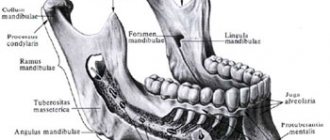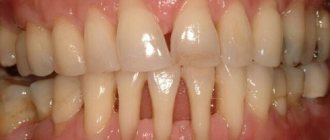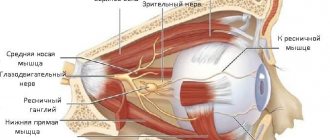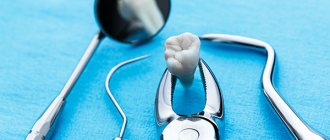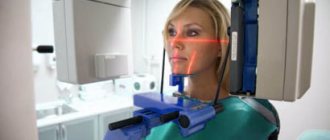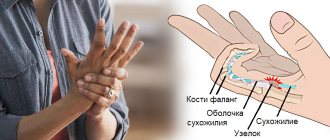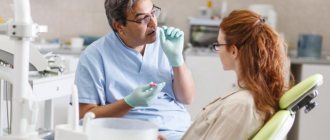The dental organs are an integral part of the masticatory apparatus.
The chewing apparatus of an adult contains 32 dental organs (16 each in the upper and lower jaws).
The dental organ consists of a tooth; the socket and the adjacent jaw, covered with the mucous membrane of the gums; ligamentous apparatus that holds the tooth in the socket; vessels and nerves.
In the tooth there are:
- crown (thickened part protruding into the tooth cavity);
- neck of the tooth (narrowed part adjacent to the crown, surrounded by gum);
- root (part of the tooth located inside the jaw socket).
TOOTH PULP
There is a cavity inside the tooth that resembles the shape of a crown, and at the root of the tooth it continues in the form of a canal. The root canal ends at the apex of the tooth root with an opening. The tooth cavity is filled with loose connective tissue, rich in blood vessels and nerves - pulp. The dental pulp is divided into crown and root parts. The pulp of the tooth crown is represented by loose connective tissue with a delicate network of collagen and precollagen fibers with a large number of cellular elements. In the tooth root pulp, collagen structures are denser, thicker and oriented longitudinally along the neurovascular bundle.
Based on the cellular composition of the pulp, they are divided into: peripheral, subodontoblastic and central layers.
The peripheral layer consists of specialized cells - odontoblasts, which take part in the metabolic processes of enamel and dentin. They are located in several rows.
The odontolast has an elongated pear-shaped shape. It has a peripheral protoplasmic process (or dentine), which runs in the dentinal tubule to the dentinoenamel junction, and short lateral processes that anastomose with neighboring cells in the early stages of differentiation.
The subodontoblastic and central layers consist of small, poorly differentiated stellate cells connected to each other by short processes. The pulp contains many fibroblasts that participate in the formation of a fibrous capsule that limits the focus of inflammation.
In the central layers there are cytoplasmic cells - histiocytes. During inflammation, they acquire the ability to move and phagocytose and are called macrophages.
The blood supply to the pulp is provided by blood vessels that penetrate into it through the opening of the apex of the tooth root and through additional canals from the periodontium. The lymphatic system in the pulp is presented in the form of slits, capillaries, and vessels. The outflow of lymph from the pulp occurs in the submandibular and mental lymph nodes. Arterial trunks accompany veins. The pulp vessels have numerous anastomoses. Through the apical foramen, sensitive pulpy and non-pulse fibers of the trigeminal nerve pass, which innervate the pulp, forming plexuses.
The dental pulp has a trophic, protective and plastic function. The trophic function is carried out due to the developed network of blood and lymphatic vessels; protective - due to histiocytes, plasma cells; plastic is the participation of the pulp in the formation of dentin.
The bulk of the tooth is dentin, which surrounds the tooth cavity. In the area of the tooth crown, dentin is covered with bright white enamel. The dentin of the root is covered with cement.
Functions of periodontium –
- Retaining function - it consists in holding the tooth in the alveolus, and the dento-alveolar fibers of the periodontium are primarily responsible for this.
- Shock absorption and distribution function - intercellular substance and periodontal fibers allow you to evenly distribute the chewing load from the tooth to the alveolar tissue.
- Protective function - the connective tissue and cellular components of the periodontium represent the so-called “histohematic barrier”, which ensures the structural and antigenic homeostasis of both the periodontium itself and the surrounding tissues. The implementation of the protective function is mediated by both specific and nonspecific protective factors.
- Plastic function - ensures the preservation of the structure of the periodontium, as well as the reparation of both the periodontium itself and adjacent tissues (for example, the bone plate of the alveolus, as well as the cement of the tooth root). The periodontium is very rich in cellular elements, including osteoblasts, which are responsible for the formation of bone tissue on the surface of the alveoli, as well as cementoblasts, on which the production of replacement cement for the tooth root will depend.
- Trophic and sensory functions are provided by a well-developed vascular and nervous network (a large number of receptors). These functions are closely related to those listed above.
PERIODONTIUM
The root of the tooth is held in the socket by connective tissue fibers that make up the root membrane or periodontium.
The periodontium is located in a narrow, slit-like space between the tooth root and the jaw bone. The thickness of the periodontium is 0.15-0.25 mm. With age, as well as from mechanical load, the thickness of the periodontium changes and amounts to 1.2-1.2 mm.
The basis of periodontal connective tissue are bundles of interdental and cemento-alveolar fibers, which are woven, on the one hand, into the compact plate of the alveoli, and on the other hand, into the cementum of the tooth root. In the area of the tooth neck, fibrous fibers have an almost horizontal direction and include numerous collagen fibers, circularly covering the cervical area (circular ligament). The apical periodontium contains more loose connective tissue and cellular elements. Fibrous fibers in the area of the tooth apex are represented by looser, more delicate bundles and are arranged radially; with the help of the fibers, the tooth is suspended and fixed in the bone bed.
The blood supply to the periodontium is abundant and it has a fairly developed lymphatic network. Periodontal vessels form several plexuses (external, middle, capillary) in the root area. Cellular elements are represented by fibroblasts, mast cells, plasma cells, histiocytes, cementoblasts, osteoblasts, and epithelial remnants of the neoplastic epithelium. The main function of the periodontium is support and retention. In addition, the periodontium distributes and regulates pressure on the tooth (shock absorbing), has a plastic function due to cellular elements and a barrier function (due to the unique anatomical structure and resistance to adverse environmental influences). The reflexogenic function of periodontium is also highlighted.
The structure of the periodontium under a microscope –
In Figure 8 below you can see collagen fibers penetrating the root cementum. Please note that the terminal sections of the fibers (located in the cement of the root or in the bone wall of the alveoli) are called Sharpey's fibers. Next, Fig. 8 shows a histological preparation of the periodontium of a tooth, where 1 – bundles of collagen fibers, 2 – the main amorphous substance, 3 – periodontal vessels.
Electron microscopy data made it possible to find out that periodontal fibers penetrate into the cement of the tooth root to a depth of only 3 to 5 μ.t, and into the bone wall of the alveoli - no more than 20 μ.t. It also became known that although periodontal fibers consist predominantly of mature type 1 collagen, it also contains some immature elastic fibers (oxytalan). These fibers are only 2-3 mm long, and they are not located perpendicularly like all steel fibers, but parallel to the surface of the tooth root. Oxytalan fibers cross the dento-alveolar fibers at right angles, and their role is to redistribute blood flow in the periodontium under conditions of chewing load.
Collagen fibers occupy only 40% of the periodontal volume, and the remaining 60% is nothing more than the main amorphous substance (which, in turn, consists of as much as 70% water). In addition to water, there is also a large number of different cellular elements present here - first of all, we are interested in fibroblasts, which are located along the collagen fibers. Fibroblasts can also differentiate into fibrocytes or myofibroblasts during the cell cycle.
Another group of cellular elements includes cementocytes and cementoblasts. The latter are located on the surface of the cementum of the tooth root, and their function is to build replacement cement. There is also a small group of cellular elements, which include osteoblasts, osteoclasts, and odontoclasts. The following are also found in small quantities in the periodontium: lymphocytes, plasma cells, mast cells, eosinophils and neutrophilic leukocytes.
Periodontal histology: video
Below in video 1 you can see the histology of tooth tissue in stunning resolution. Video 2 is the best lecture on periodontal histology you can ever hear. The video is in English, but if you wish, you can turn on subtitles, and then select translation from English into Russian in the settings.
DENTINE
Dentin in its structure resembles coarse-fibrous bone tissue, consisting of a basic substance penetrated by a large number of dentinal tubules. The main substance of dentin consists of collagen fibers, between which there is an amorphous adhesive substance. The outer layer of dentin (with a radial arrangement of fibers) is called mantle; the inner layer with a tangential arrangement of fibers is peripulpar. Dentinal tubules (tubules) have the shape of round, oval tubes. They begin in the tooth cavity, bending in a wave-like manner, pass through the thickness of the dentin and end in flask-shaped swellings in the area of the dentino-enamel junction.
In the lumen of these tubules there are dentinal processes of odontoblasts. Dentin contains 70-72% inorganic substances (mainly phosphate and calcium carbonate), and 28-30% is water and organic matter (proteins, fats and carbohydrates).
Tooth enamel Tooth enamel is the hardest tissue of the human body. In the area of the cusps of the tooth crown there is the thickest layer of enamel; towards the cervical area the thickness of the enamel decreases. Enamel prisms are the main structural formation of enamel. The enamel prism is a faceted cylindrical fiber that begins at the dentinoenamel junction.
It bends in an S-shape, runs radially and ends on the surface of the tooth crown. Enamel prisms are connected into bundles (10-20 each), directed radially from the dentinoenamel junction to the outer surface. The thickness of the prisms is from 3 to 6 microns. Each prism contains thin cytoplasmic fibers that form an organic mesh, in the loops of which crystals of mineral salts are located.
Enamel prisms and interprismatic spaces (in electron microscopic examination) consist of strictly oriented hydroxyapatite crystals arranged in a certain order, the length of which ranges from 50 to 100 nm.
Most of the tooth enamel consists of inorganic matter (95%), organic (1.2%) and water (3.8%). Tooth enamel contains 96.5% mineral salts, of which about 54% are phosphorus and calcium (17% and 37%, respectively), which are represented by hydroxyapatite crystals.
ANATOMIC AND PHYSIOLOGICAL FEATURES OF PERIODONTAL
The periodontium is a complex anatomical formation of connective tissue origin, located between the compact plate of the dental cell and the cementum of the tooth root (Fig.). Throughout its entire length, the periodontium is in direct connection with the jaw bone, through the apical foramen - with the dental pulp, and at the edges of the cell - with the gum and periosteum of the jaw.
The periodontium is first detected at the follicular stage of tooth development with the beginning of root formation and simultaneously develops with its growth and the formation of the cortical plate of the alveoli. Periodontal formation ends approximately a year after the end of development of the apex of the tooth root. On average, the thickness of the periodontium is 0.20-0.25 mm, but this value can change with age, tooth development, its function and, finally, as a result of the pathological process. In a formed, but not yet erupted tooth, the thickness of the periodontium is 2 times less (0.05-0.1 mm) than in a normally functioning tooth. With the loss of the antagonist, the width of the periodontal fissure decreases to 0.10-0.15 mm. In adulthood, the periodontal fissure becomes wider due to thickening of the periodontium. According to E.M. Gofung, the width of the periodontal fissure on the lower jaw is slightly smaller (0.15-0.22 mm) than on the upper jaw (0.20-0.25 mm). The width of the periodontal gap in human teeth varies even in its individual sections. In the middle third of the root, the periodontal fissure is narrowed and funnel-shaped expanded at the apex of the interalveolar septum and in the apical third due to micromovements of the tooth in the socket. Changes in periodontal thickness can be observed in connection with the pathological process. With increased load on the tooth, thickening (hypertrophy) of the periodontium and changes in the bone structure of the socket occur, which can lead to expansion of the periodontal gap. With cement hypertrophy (hypercementosis), the contours and size of the periodontal gap may also change. The consequence of the inflammatory process may be resorption of not only the walls of the socket, but also the cement of the root. The periodontium is formed by connective tissue, in which intercellular substance is distinguished; it contains fibrous collagen fibers and layers of loose connective tissue, penetrated by blood and lymphatic vessels and nerves. In the root apex region there is less fibrous tissue, but more loose connective tissue. The periodontium contains a small amount of thin argyrophilic fibers. Collagen fibers are formed from polypeptide molecules, which is responsible for the cross-striations of collagen fibrils, detected under an electron microscope. Fibrous fibers are folded into thick bundles, reaching 5-10 microns in diameter. The fibrous bundles of the periodontium are woven into the cementum of the tooth root at one end and pass into its fibrous structures, and at the other end into the bone tissue of the alveoli, providing a close connection between the periodontium and the surrounding tissues. At the alveolar wall, the collagen bundles are coarser than at the root cementum, where they form a delicate network. Collagen fibers of different parts of the periodontium differ in their direction and thickness of the bundles they form. The most powerful group consists of the so-called transseptal fibers. These are bundles of fibers running horizontally and connecting adjacent teeth. The bundles of fibers that make up this group are thick and fit tightly to each other. There is almost no layer of loose connective tissue between them. Above the transseptal group are bundles of collagen fibers that make up the lamina propria of the gums. Some of these fibers, acquiring an oblique direction, enter the cement. Directly around the neck of the teeth, intersecting with the transseptal group, there runs a relatively small group of fibers with a circular arrangement, called the circular ligament. Fibers of this group can break up into separate bundles. Starting from the top of the alveolar ridge and further along the entire periodontium, there are bundles of fibers that have an oblique direction, i.e., running at an angle to the longitudinal axis of the tooth. The places where fibrous bundles enter the bone of the socket are located above the places where these bundles enter the root cement. The bundles of fibrous collagen fibers located in this way tightly fix the tooth in the dental cell, the tooth seems to hang in the alveolus (Fig. 8.2). The functional orientation of periodontal fibers, like the trabeculae of the cancellous jaw bone, begins before they are included in the function during tooth eruption. In the apical part of the root, as in the cervical region of the periodontium, a certain number of fibrous bundles run in the radial direction, which prevents and limits the lateral movements of the tooth (Fig. 8.3). The vertical arrangement of collagen fibers to the bottom of the alveoli in the apical part of the periodontium prevents the tooth from moving out of the socket. The bundles of fibers running from the cement to the alveolar bone are connected to each other by numerous lateral anastomoses. These anastomoses can be considered as a kind of additional distributors of chewing load throughout the periodontium. Taking into account the difference in the direction and organization of collagen fiber bundles, they should be classified as follows: transseptal fibers; loose gum fibers (coming from the neck of the tooth and woven into the connective tissue of the gums); circular fibers (covering the neck of the tooth); alveolar ridge fibers (passing from the top of the alveolar ridges to the cement of the neck (tooth); oblique fibers; a group of apical fibers. Although the above groups of fibers can be traced in the periodontium of all teeth, nevertheless, the periodontium of functionally different teeth differs in structure. So, for teeth of the frontal group (incisors, canines) it is characteristic that the bundles of fibers that make up the periodontal tissue are relatively thin. This especially applies to the circular group covering the area of the tooth neck. The group of oblique fibers is divided into separate fragments by triangular spaces filled with loose connective tissue. Angle of inclination of these fibers is approximately 40-45° in the vestibular part of the periodontal fissure and 35° in the oral part. It should be noted that the angle of inclination of the fibers also varies in different parts of the periodontal fissure. In the periodontal area immediately following the neck of the tooth, the angle of inclination of the fibers fluctuates (25-35°).Below this level, the inclination of the fibers increases to 45-50°. And finally, in the periapical region, some of the fiber bundles, as noted above, take on an almost vertical direction. It should be noted that the group of underlying fibers in the anterior teeth is relatively small. Here one can observe a rather dense plexus of argyrophilic fibers. In the periodontium of small molars (group of premolars), bundles of collagen fibers thicken. This applies to both the circular and transseptal groups. The fibers going to the bucco-lingual direction are more clearly expressed here. The angle of inclination of the fibers of the oblique group was 20-25° in the cervical region, then increasing to 50-60°. In the group of fibers underlying the root apex, a cross-shaped weave is clearly visible. The periodontium of large molars (molars) is characterized by the presence of powerful transseptal and circular fibers, as well as thick bundles in the apical region of the periodontium, which seem to create a litter for the root apex. Also noteworthy are the well-developed bundles of fibers running in the horizontal direction and connecting the crest of the alveolar process with the cementum of the tooth root. The angle of inclination of the obliquely located fibers also increases more gradually from 20° in the cervical region to 40° in the middle sections of the root length. Particular attention should be paid to the fibers in the bifurcation area of multi-rooted teeth. The upper part of these fibers, connecting the crest of the alveolar septum with the cementum of the roots in the bifurcation region, resembles the alveolar ridge fibers in location. In addition, above the apex of the alveolar septum there are fibers running in a horizontal direction and seemingly connecting the roots of the teeth. These fibers form particularly complex weaves in teeth that have three roots. Below these fibers follow oblique fibers, basically repeating the direction of the fibers of the opposite sections of the periodontal fissure. The periodontium of teeth contains elastic fibers, but they are few. These are mainly thin fibers located between the bundles of collagen fibers of the periodontal ligament. It should be noted that these elastic elements are more often found in the periodontium of incisors and canines among the fibers of the cervical group. One of the features of periodontium is the presence of a significant amount of oxytalan fibers, so named for their resistance to acids. They are a permanent component of periodontal connective tissue. Their distribution is also uneven; they are more often found in the fibers of the cervical group and in the periapical region. Periodontal oxytalan fibers are a type of elastic fiber. The content of oxytal fibers and their thickness increase in the periodontium of teeth experiencing increased functional load. Oxytalan fibrils form a dense network that is woven between collagen fibers. Oxytalan fibers, connecting with periodontal blood vessels, form oxytalan-vascular structures. It has been established that, along with the plastic function, the oxytalan system is part of the periodontal receptor mechanism, which controls vascular tone. In the periodontium of teeth, especially multi-rooted ones, there are argyrophilic fibers, which morphologically are very similar to the argyrophilic fibers of reticular tissue. These fibers are most often detected in periodontal areas communicating with the medullary spaces of the jaw. Between the connective fibers in the periodontium there are cellular elements - fibroblasts with an oval nucleus and light cytoplasm, in loose connective tissue - mast cells and histiocytes (wandering cells) with a more brightly colored small nucleus and granular cytoplasm. Near the vessels and capillaries of the periodontium, perivascular adventitial histiocytes and mast cells are found. Mast cells have both a round and elongated shape. It has been established that the granularity of mast cells includes heparin and histamine, which are involved in the regulation of the permeability of the main substance of periodontal connective tissue. Plasma cells are mainly localized in the cervical region. They have a round shape with a sharply basophilic cytoplasm, a round nucleus and a characteristic arrangement of chromatin clumps. In the areas of the periodontium adjacent to the root cement, there are cementocytes - cells that have a plastic function in the construction of secondary (cellular) cement, and in the areas adjacent to the alveolus, there are osteoblasts - builders of the alveolar bone tissue. However, the set of cellular elements in different areas of the periodontium is different. A larger number of young, poorly differentiated cells are characteristic of the periapical and cervical zones of the periodontium, and in multi-rooted teeth, such an area is also the periodontium in the area of root bifurcation. In the middle sections of the periodontal fissure, more mature forms of fibroblasts predominate. It is characteristic that the number of plasma cells and mast cells is subject to the same fluctuations. In addition to these cells of connective tissue origin, epithelial formations are located closer to the cement - the so-called epithelial remains (relictum epitheliale). It is widely believed that these epithelial formations are the remnants of tooth-forming epithelium, which remains in the periodontium of the teeth throughout life. Domestic authors have proven the heterogeneity of the origin of these epithelial elements: in the periapical part of the tooth root they are remnants (islands, nests) of the perihilar epithelial sheath, and in the area of the tooth neck - remnants of the dental plate. The places of greatest localization of epithelial cells are the cervical and periapical parts of the periodontium. Here the largest complexes of these cells are revealed. The shapes and sizes of accumulations of epithelial cells are different. In some cases they look like a small group of cells, in others they look like short strands. It is very characteristic that the content of these epithelial remains is subject to pronounced age-related fluctuations. The largest amount of epithelial remains is found in the periodontium of people aged 10-20 years. A significant number of these cells are contained in the periodontium of people aged 21–30 years. At the same time, in the periodontium of people over 50 years of age, their number noticeably decreases. At the same time, the morphological structure of the residues themselves changes. In young people, larger epithelial complexes with fairly clear nuclear structures are observed, while in older people, these cells have a narrow rim of cytoplasm and a pyknotic dark-colored nucleus. The content of epithelial nests is reduced in the periodontium of teeth bearing a functionally increased load. Many authors argue that the epithelium of these nests, under certain conditions, can lead to the appearance of both benign (cystogranulomas, cysts) and malignant (cancerous) neoplasms.
TOOTH CEMENT
The cementum of the tooth covers the root and is divided into primary and secondary. Primary (cell-free) cement is adjacent directly to dentin, covering the lateral surfaces of the tooth root. Secondary (cellular) contains cementocides, covers a layer of primary cement, is localized only in the area of the root apex and on the interroot surfaces of premolars and molars.
The main substance of cement is represented by collagen fibers running in different directions, most of which run in the radial direction. In some pathological conditions, hypercementosis is observed (excessive deposition of layers of cement on the surface of the tooth root). Cement consists of 68% inorganic and 32% organic substances.
Functions
- supporting and holding. Perception and redistribution of pressure during chewing.
- reflexogenic. Regulation of chewing loads due to the fact that the periodontium contains many nerve endings.
- plastic. Promotes the restoration of ligaments and the formation of alveolar walls. Performed by osteoblasts, cementoblasts and fibroblasts.
- trophic. It is carried out with the help of nerves and capillaries and is associated with chewing pressure.
- barrier It is performed with the help of histiocytes, which do not allow pathogenic bacteria to penetrate into the tooth root area.
- sensory.
Additionally, we note that without periodontium, teething in infants is impossible; it regulates the adaptation of the tooth to the stresses that arise during chewing and biting food, performs a reparative function in the event of a tooth root fracture, and also provides root protection with the help of leukocytes and macrophages.
How does pathological resorption and resorption of roots with intact periodontium proceed?
If intact periodontium is in contact with the root, the process usually involves osteoclasts and, at later stages, pulp tissue. They promote more intensive resorption of dentin from the side of the tooth cavity.
If there is chronic inflammation in the periodontium, the cells of the inflammatory infiltrate are involved in the resorption process. Instead of connective tissue, granulation tissue is formed. As a result of resorption, small and medium-depth lacunae filled with granulations are formed. With a pathological course, resorption of not yet fully formed roots is possible. It also spreads to the rudiments of permanent teeth, accelerates the resorption of parts of the follicle and initiates the premature eruption of molars.
